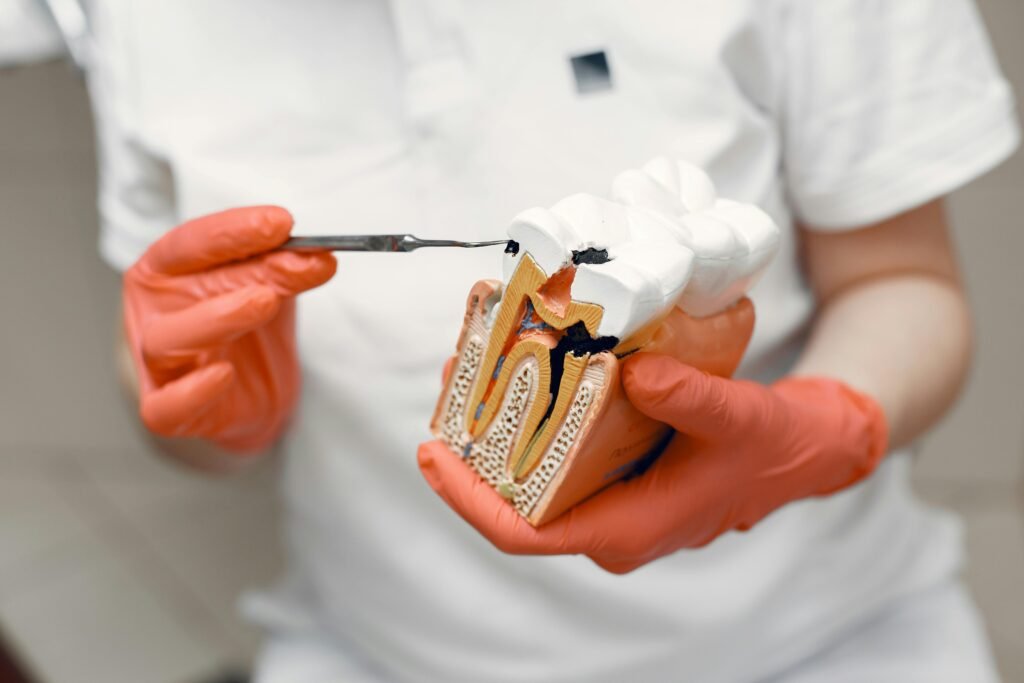Vital Pulp Therapy (VPT) is a conservative dental procedure designed to treat teeth affected by trauma or decay while maintaining the health of the pulp—the soft tissue inside the tooth. The primary goal of VPT is to keep the pulp alive, preserving the tooth’s natural function and avoiding more invasive procedures such as root canal therapy or extraction.
VPT is ideal for cases where the pulp is not extensively damaged or infected. By carefully removing damaged tissue, disinfecting the area, and filling the pulp chamber with bioactive materials, the tooth can often heal naturally and retain its vitality.
Types of Vital Pulp Therapy
Dental professionals use three main approaches based on the condition of the pulp and tooth:
1. Indirect Pulp Capping
Used when decay or trauma approaches but does not expose the pulp. The dentist removes decayed tissue while preserving affected dentin, then applies a protective filling to stimulate pulp healing.
2. Direct Pulp Capping
Applied when a small pulp exposure occurs. Damaged tissue is cleaned, and a biocompatible material is applied directly to the pulp to promote natural repair.
3. Pulpotomy
Involves removal of the infected coronal pulp while preserving healthy radicular pulp. Often used for shallow decay or reversible pulpitis, this procedure maintains tooth vitality and function.
Materials Used in Vital Pulp Therapy
Material selection depends on the tooth condition, procedure type, and dentist preference:
- Calcium Hydroxide: Stimulates reparative dentin formation; antimicrobial properties. Ideal for indirect pulp capping.
- Mineral Trioxide Aggregate (MTA): Biocompatible, excellent sealing properties; used in direct pulp capping and pulpotomy.
- Glass Ionomer Cement (GIC): Releases fluoride, supports long-term tooth protection.
- Adhesive Resin: Used to bond restorations such as fillings or crowns post-VPT.
The right material ensures optimal healing and long-term success.
Contraindications for Vital Pulp Therapy
VPT may not be suitable in cases where pulp preservation is unlikely to succeed:
- Pulp Necrosis: Dead or severely infected pulp cannot be saved.
- Periapical Pathology: Abscess or infection at the root tip requires alternative treatment.
- Severe Trauma: Fractures extending into the pulp chamber may prevent healing.
- Large Pulp Exposure: Extensive damage reduces treatment effectiveness.
- Medical Conditions: Compromised immunity or systemic conditions may impact success.
Consultation with a dentist or endodontist is essential to determine treatment suitability.
Success Rates and Prognosis
VPT has a high success rate, especially when performed early and using appropriate materials:
- Indirect Pulp Capping: 80–90% success
- Direct Pulp Capping: 87.5% success over 14 months
- Pulpotomy: 94.6% success over 18 months
A systematic review of direct pulp capping procedures published in the Journal of Endodontics in 2015 reported a success rate of 87.5% over a median follow-up period of 14 months. Another study published in the same journal in 2018 reported a success rate of 94.6% for pulpotomy procedures over a mean follow-up period of 18 months.
Success factors include patient age, pulp exposure size, bacterial contamination, and material choice. Teeth may occasionally require further treatment if VPT is unsuccessful.
Advantages of Vital Pulp Therapy
- Preserves natural tooth vitality and sensation
- Minimally invasive compared to root canal therapy
- Maintains structural integrity of the tooth
- Reduces treatment time and post-procedure discomfort
- Improves long-term prognosis
Case Example
Complete Pulpotomy by Dr. Hasan AbuMaizar
A patient presented with shallow decay and pulp inflammation. Dr. Hasan performed a pulpotomy, preserving the healthy pulp, restoring tooth function, and preventing further intervention.
Why Choose AbuMaizar Dental Center
At AbuMaizar Dental Center in Amman, Dr. Hasan AbuMaizar combines clinical expertise with advanced materials and modern techniques to ensure predictable outcomes in VPT. Every procedure is tailored to individual patient needs, maximizing healing and comfort.
Book Your Appointment | Learn About Root Canal Therapy | Our Dental Services

